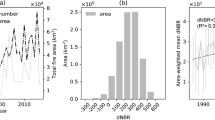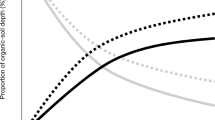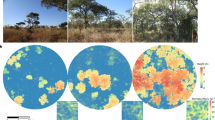Abstract
Climate change has increased the area affected by forest fires each year in boreal North America1,2. Increases in burned area and fire frequency are expected to stimulate boreal carbon losses3,4,5. However, the impact of wildfires on carbon emissions is also affected by the severity of burning. How climate change influences the severity of biomass burning has proved difficult to assess. Here, we examined the depth of ground-layer combustion in 178 sites dominated by black spruce in Alaska, using data collected from 31 fire events between 1983 and 2005. We show that the depth of burning increased as the fire season progressed when the annual area burned was small. However, deep burning occurred throughout the fire season when the annual area burned was large. Depth of burning increased late in the fire season in upland forests, but not in peatland and permafrost sites. Simulations of wildfire-induced carbon losses from Alaskan black spruce stands over the past 60 years suggest that ground-layer combustion has accelerated regional carbon losses over the past decade, owing to increases in burn area and late-season burning. As a result, soils in these black spruce stands have become a net source of carbon to the atmosphere, with carbon emissions far exceeding decadal uptake.
This is a preview of subscription content, access via your institution
Access options
Subscribe to this journal
Receive 12 print issues and online access
$259.00 per year
only $21.58 per issue
Buy this article
- Purchase on Springer Link
- Instant access to full article PDF
Prices may be subject to local taxes which are calculated during checkout



Similar content being viewed by others
References
Gillett, N. P., Weaver, A. J., Zwiers, F. W. & Flannigan, M. D. Detecting the effect of climate change on Canadian forest fires. Geophys. Res. Lett. 31, L18211 (2004).
Kasischke, E. S. & Turetsky, M. R. Recent changes in the fire regime across the North American boreal region—spatial and temporal patterns of burning across Canada and Alaska. Geophys. Res. Lett. 33, L09703 (2006).
Bond-Lamberty, B., Peckham, S. D., Ahl, D. E. & Gower, S. T. Fire as the dominant driver of central Canadian boreal forest carbon balance. Nature 450, 89–92 (2007).
Kurz, W. A., Stinson, G. & Rampley, G. Could increased boreal forest ecosystem productivity offset carbon losses from increased disturbances? Phil. Trans. R. Soc. Lond. B 363, 261–269 (2008).
Balshi, M. S. et al. Vulnerability of carbon storage in North American boreal forests to wildfires during the 21st century. Glob. Change Biol. 15, 1491–1510 (2009).
French, N. H. F., Goovaerts, P. & Kasischke, E. S. Uncertainty in estimating carbon emissions from boreal forest fires. J. Geophys. Res. 109, D14S08 (2004).
Giglio, L., van der Werf, G., Randerson, J. T., Collatz, G. J. & Kasibhatla, P. Global estimates of burned area using MODIS active fire observations. Atmos. Chem. Phys. 6, 957–974 (2006).
Amiro, B. D. et al. Direct carbon emissions from Canadian forest fires, 1959–1999. Can. J. Forest Res. 31, 512–525 (2001).
Kasischke, E. S. & Johnstone, J. F. Variation in post-fire organic layer thickness in a black spruce forest complex in Interior Alaska and its effects on soil temperature and moisture. Can J. Forest Res. 35, 2164–2177 (2005).
Yi, S. et al. Interactions between soil, thermal and hydrological dynamics in the response of Alaska ecosystems to fire disturbance. J. Geophys. Res. 114, G02015 (2009).
Johnstone, J. F., Hollingsworth, T. N., Chapin, F. S. III & Mack, M. C. Changes in fire regime break the legacy lock on successional trajectories in Alaskan boreal forest. Glob. Biogeochem. Cycles 16, 1281–1295 (2010).
Amiro, B. D., Cantin, A., Flannigan, M. D. & de Groot, W. J. Future emissions from Canadian boreal forest fires. Can. J. Forest Res 39, 383–395 (2009).
Duffy, P. A., Walsh, J. E., Graham, J. M., Mann, D. H. & Rupp, T. S. Impacts of large-scale atmospheric-ocean variability on Alaskan fire season severity. Ecol. Appl. 15, 1317–1330 (2005).
Xiao, J. & Zhuang, Q. Drought effects on large fire activity in Canadian and Alaskan forests. Environ. Res. Lett. 2, 10.1088/1748-9326/2/4/044003 (2007).
Slaughter, C. W. & Viereck, L. A. in Forest Ecosystems in the Alaskan Taiga (eds Van Cleve, K., Chapin, F. S. III, Flanagan, P. W., Viereck, L. A. & Dyrness, C. T.) 22–43 (Springer, 1986).
Harden, J. W., Meier, R., Darnel, C., Swanson, D. K. & McGuire, A. D. in Studies in Alaska by the US Geological Survey (ed. Galloway, J.) 139–144 (US Geological Survey Professional Paper 1678, 2001).
Kasischke, E. S. et al. Alaska’s changing fire regime—implications for the vulnerability of boreal forests. Can. J. Forest Res. 40, 1360–1370 (2010).
Flannigan, M. D., Logan, K. A., Amiro, B. D., Skinner, W. R. & Stocks, B. J. Future area burned in Canada. Clim. Change 72, 1–16 (2005).
Tarnocai, C. et al. Soil organic carbon pools in the northern circumpolar permafrost region. Glob. Biogeochem. Cycles 23, GB2023 (2009).
McGuire, A. D. et al. Sensitivity of the carbon cycle in the Arctic to climate change. Ecol. Monogr. 79, 523–555 (2009).
Randerson, J. T. et al. The impact of boreal forest fire on climate warming. Science 314, 1130–1132 (2006).
Lyon, E. A., Jin, Y. & Randerson, J. T. Changes in surface albedo after fire in boreal forest ecosystems of interior Alaska assessed using MODIS satellite observations. J. Geophys. Res. 113, G02012 (2008).
Hinzman, L. et al. Evidence and implications of recent climate change in northern Alaska and other arctic regions. Clim. Change 72, 251–298 (2005).
Schuur, E. A. G. et al. The effect of permafrost thaw on old carbon release and net carbon exchange from tundra. Nature 459, 556–559 (2009).
Kasischke, E. S. et al. Evaluation of the composite burn index for assessing fire severity in Alaskan black spruce forests. Int. J. Wildland Fire 17, 515–526 (2008).
Ottmar, R. D. & Sandberg, D. V. in Proc. Fire Conf. 2000: The First National Congress on Fire Ecology, Prevention, and Management (eds Galley, K. E. M., Klinger, R. C. & Sugihara, N. G.) 218–224 (Tall Timbers Res. Sta., 2003).
Harden, J. W., Manies, K. L., Turetsky, M. R. & Neff, J. C. Effects of wildfire and permafrost on soil organic matter and soil climate in interior Alaska. Glob. Change Biol. 12, 2391–2403 (2006).
Stocks, B. J. et al. Canadian forest fire danger rating system: An overview. Forest Chron. 65, 450–457 (1989).
Balshi, M. S. et al. The role of fire disturbance in the carbon dynamics of the pan-boreal region: A process-based analysis. J. Geophys. Res. 112, G02029 (2007).
Johnson, K. & Harden, J. An Alaskan soil carbon database. Eos Trans. AGU 90, 184 (2009).
Acknowledgements
We thank L. Ness for remote sensing analyses, A. McAdam for R programming, E. Ellicott, G. Shetler, C. Treat and N. French for laboratory and field assistance and M. Flannigan, B. DeGroot, D. McGuire and S. Liu for helpful comments. This study was supported by NASA (grant NNG04GD25G), the Bonanza Creek Long-Term Ecological Research Program and US Forest Service (grant PNW01-JV11261952-231 and NSF DEB-0080609), the Joint Fire Science Program (project 03-1-3-08) and the USGS Mendenhall Postdoctoral and Earth Surface Dynamics Programs.
Author information
Authors and Affiliations
Contributions
All authors collected data, and commented on the manuscript at all stages. E. S. Kasichke led the geospatial analyses with help from E.H. E. S. Kane led the compilation of soil carbon data with help from J.W.H., K.L.M. and M.R.T. M.R.T. analysed statistical data, led the overall synthesis and wrote the paper.
Corresponding author
Ethics declarations
Competing interests
The authors declare no competing financial interests.
Supplementary information
Supplementary Information
Supplementary Information (PDF 931 kb)
Rights and permissions
About this article
Cite this article
Turetsky, M., Kane, E., Harden, J. et al. Recent acceleration of biomass burning and carbon losses in Alaskan forests and peatlands. Nature Geosci 4, 27–31 (2011). https://doi.org/10.1038/ngeo1027
Received:
Accepted:
Published:
Issue Date:
DOI: https://doi.org/10.1038/ngeo1027
This article is cited by
-
Millennial-aged pyrogenic carbon in high-latitude mineral soils
Communications Earth & Environment (2024)
-
Forest composition change and biophysical climate feedbacks across boreal North America
Nature Climate Change (2023)
-
Wildfire precursors show complementary predictability in different timescales
Nature Communications (2023)
-
Shortened Fire Intervals Stimulate Carbon Losses from Heterotrophic Respiration and Reduce Understorey Plant Productivity in Boreal Forests
Ecosystems (2023)
-
The relationship between fire severity and burning efficiency for estimating wildfire emissions in Mediterranean forests
Journal of Forestry Research (2023)



